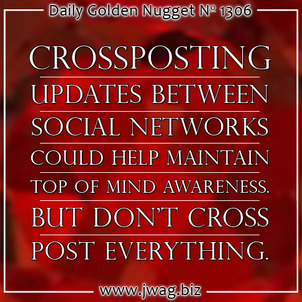
When you consider the time it takes to be involved with Facebook, Twitter, Pinterest, Instagram, Google+ and so many social networks, it's no wonder so many people live their lives carrying their smartphone in their hand all day. So many people have traded everyday verbal conversations for terse text conversations and deluges of selfies.
Those who have chosen a smartphone-tethered life, now find it second nature to use social network as a way to keep their friends and family informed. It's not a form of direct communication, but a way to share what's important to you while letting your friends and family casually discover your latest personal news.
The social networks are all working on mathematical models to calculate which people are important to each of us so they can feed us their updates quickly. Whether you like it or not, social networks have created a new way for us to stay connected to the people we care about.
Each social network gives us a different way to express our feeling and share our lives. As I write this, some of my personal friends have just posted selfies while driving to work, commented on political issues on Facebook, and complained about road rage on Twitter. Those selfies posted to Instagram are often cross posted to Facebook.
Last night one of my friends posted a selfie to Instagram showing his visit to a lake. It wasn't until I looked at his Facebook feed this morning that I discovered he was at the Montreux Jazz Festival in Switzerland, which is on Lake Leman. I liked and commented on several dozen photos he posted there. It's important to realize that I didn't log into Facebook this morning with the intention of looking at lake and jazz festival photos, but it was that cross posted photo from Instagram that I recognized, and it reminded me that my interest was piqued last night.
While we all might use several social networks, there will always be one that we check more than all the others. I've noticed that most people have developed good social media skills in the recent years. Instead of posting the same information everywhere, there's a more discerning approach of what should be posted where.
In the early days of Facebook, I cringed as friends of mine would log in once a day simply to rapid post several status updates, photos, and shared links, then quickly log off believing they had just shared important stuff with their friends. Facebook now prevents this type of bad friend activity from flooding your feed.
What I find interesting about social media activity is that, on a personal level most people now seem to understand how to use it to keep their friends connected. Yet, the same people are confused by how to use it for their business. Perhaps the mental barrier occurs because, as a business owner, you want to either sell something or pay for an ad to sell something. That confusion is happening today because advertising is shifting from a push strategy where you pay for ads to appear, to a pull strategy of placing interesting information and images where people can easily find them, then create an online breadcrumb trail to discovery.
As a business, you don't have to actively use social networks to start conversations with customers, or comment on their personal posts. Save all that time for when you need to reply to customers who react directly to your business posts.
Naturally the big difference between using social media for business and pleasure is that, as business owners, we need to eventually make money from that social activity. I've seen successful sales that started with a 1-to-1 conversation on a Twitter and Facebook. While there will always be services offering e-commerce methods through social networks, most notably Facebook, I've not seen any retail jewelers being successful when using them.
For the last few years the most popular internet marketing buzz words have been "brand" and "engagement," yet no one bothers to explain what they really mean. A "brand" is simply your business. The old concept of branding or brand awareness has been shortened to refer to how you portray your business online through all methods of marketing, social media, and other online visibility. The word "engagement" refers to the process of customers discovering what you post online, their comments about your posts, and how you reply to their comments. This engagement process is also referred to as a "conversation."
That "engagement" process is how that pull strategy of marketing works. In practice you have to put information on your website that fully details the service or product you are selling. That information needs to include photos, product descriptions, stories, reviews, and even videos. You will need a lot of photos shot on something more than a simple white background. Share different parts of the stories to different social networks, using different photos too.
Those interested in your product will notice you and dig deeper to discover more. You never know where the path of social discovery will start, which is why you need to pay attention to any comments made on your social accounts. Your initial posts, their comments, and your replies back make up that social engagement process, which eventually leads all people back to your website, or in your store, where you can make a sale.
Far too many companies are creating simple sets of ads and plastering them throughout all their marketing channels. This push strategy of marketing doesn't work well any more. Think out of the box and create marketing campaigns centered around discovery and storytelling.








